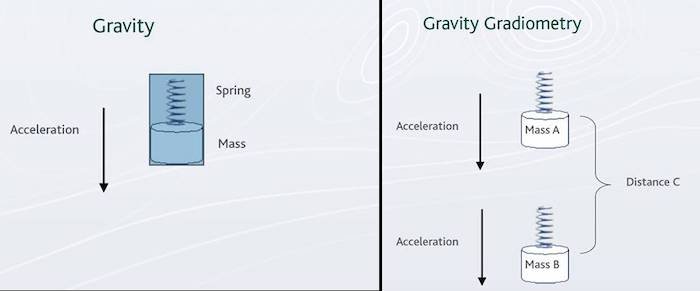How Asia Pacific is Leading the Way in Quantum Cryptography Advancements
SOURCE: HTTPS://CITYLIFE.CAPETOWN/
NOV 06, 2023
Researchers Break Below the Earth’s Surface with Quantum Gravity Gradiometer
SOURCE: ALLABOUTCIRCUITS.COM
MAR 19, 2022

Alongside quantum computing, quantum sensing is another essential future quantum technology that engineers have been working towards turning into a reality.
Over the last couple of years, studies concerning quantum sensors have come out of multiple institutions utilizing different technologies with applications in various fields.
More recently, however, quantum gravity gradiometers have become a prevalent quantum sensor research topic.

General overview of gravity gradiometry. Image used courtesy of David Jackson
Gravity gradiometry, or the study of detecting and observing discrepancies in Earth’s gravitational field in the form of a gravity gradient, is a geodesy method used primarily in the exploitation of natural resources and navigation and in navigation surveying underground and undersea masses.
This article focuses on a new research study from the University of Birmingham that applies the cold atom quantum sensing technology to develop an advanced gravity gradiometry technology that is supposed to be more capable than its electronic counterparts.
The most recent development in quantum gravity gradiometry comes from a team of researchers at the University of Birmingham.
Developed as part of the Gravity Pioneer project under contract from the Ministry of Defense of the United Kingdom, this study set out to take quantum gravity sensing outside of the lab and into real-world situations.
To achieve this, the team of scientists, led by Dr. Michael Holynski, utilized the properties of cold atom clouds. By implementing an 'hourglass' configuration of two clouds of atoms, separated by a vertical baseline, the team measured slight changes in the pulling force of a gravitational field when the two atom clouds get dropped.

Rendering of an hourglass gradiometer. Image used courtesy of Stray et al
This capability is possible because when an underground object is larger, the difference between the density of the thing and its surroundings is more significant. This discrepancy can then be observed and measured by gravity gradient sensing techniques.
The particular technique used in this experiment uses special laser-based instruments to cool the atom clouds down to only a couple of hundred nanokelvins which gives the sensor its 'quantum' nature.
Cooling atoms to temperatures near absolute zero reveal their wave-like characteristics. The quantum mechanical laws take over from the classical physics ones, allowing scientists to exploit the quantum particle properties of the atoms in their experiments.
Taking measurements from this sensor is based on the scientific method called interferometry, where the interference of superimposed waves (in this case, the 'hourglass' configuration of the two atom clouds) is used to extract some information, in this case, the gravity gradient.
Even though atom interferometry for gravity gradient mapping isn't a new idea and has been proposed for the development of sensors as far back as the late 1980s, this is the first study to succeed in real-world measurements outside of the lab with the potential to become a future commercial product.

A high-level perspective of quantum gravity gradiometry. Image used courtesy of Stray et al
According to the researchers from the University of Birmingham, by using their technique, they were able to successfully eliminate the effects of:
By finding the effects of these features, their sensor claims to be superior to electronic ones by allowing for shorter times between each reading as well as a much higher spatial resolution.
There is no doubt that quantum sensors are being progressively established as a mainstream technology. Each quantum-related research study that comes out of institutions such as the University of Birmingham and even NASA shows just what might become possible in the future by exploiting the quantum nature of particles and using it to our advantage.
Moreover, for this study, in particular, geological surveys are important in the manufacturing, building, and fueling of our current technologies in industries ranging from electronic and electrical to civil engineering.
Many scientific fields also rely heavily on these geographical methods, allowing for insight underneath the Earth's surface, in the depths of our oceans, and up into the atmosphere itself.
As one such method, gravity gradiometry has a lot of potential in improving these fields and industries by shortening surveying times and lowering the financial barrier to entry for companies and researchers.
This is why addressing the challenges that electronic gravity gradient sensors face, especially by innovating in the quantum field, can lead to:
All in all, the investigation and improvement of sensing technology are pivotal in pushing towards the future.
LATEST NEWS
Augmented Reality
Hi-tech smart glasses connecting rural and remote aged care residents to clinicians
NOV 20, 2023
WHAT'S TRENDING


Data Science
5 Imaginative Data Science Projects That Can Make Your Portfolio Stand Out
OCT 05, 2022

SOURCE: HTTPS://CITYLIFE.CAPETOWN/
NOV 06, 2023
SOURCE: HTTPS://WWW.SCIENCEDAILY.COM/
OCT 27, 2023
SOURCE: HTTPS://WWW.SCIENCEDAILY.COM/
OCT 26, 2023
SOURCE: HTTPS://THEQUANTUMINSIDER.COM/
SEP 28, 2023
SOURCE: HTTPS://TECHMONITOR.AI/
OCT 03, 2023
SOURCE: HTTPS://SCITECHDAILY.COM/
AUG 29, 2023
SOURCE: HTTPS://WWW.DIGITALJOURNAL.COM/
AUG 26, 2023
SOURCE: HTTPS://WWW.TECHTIMES.COM/
AUG 16, 2023